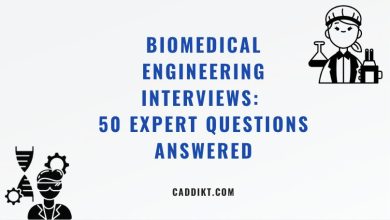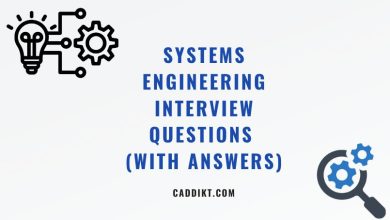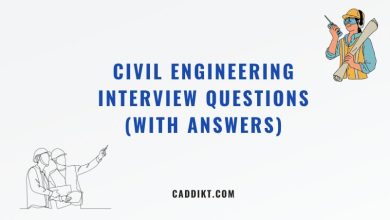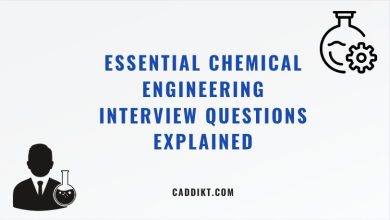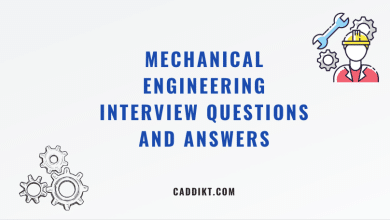Welcome to our comprehensive guide to industrial engineering interview questions and answers. Whether you’re a recent graduate or an experienced professional, preparing for an industrial engineering interview can be a daunting task. In this article, we have compiled a list of 50 commonly asked interview questions in the field of industrial engineering. We not only provide the questions but also concise, human-written answers that will help you understand the key concepts and ace your interview. From the fundamentals of industrial engineering to specific topics like process optimization, supply chain management, and quality control, this guide covers a wide range of essential topics. So, let’s dive in and gain the knowledge and confidence you need to succeed in your industrial engineering interviews!
Disclaimer: The answers provided here are for reference purposes and should be used as a starting point to develop your own responses based on your knowledge and experience.
Prepare for Success: 50 Industrial Engineering Interview Questions Explained
1. What is Industrial Engineering, and what are its main objectives?
Industrial Engineering is a field that focuses on optimizing processes and systems to improve efficiency and productivity in various industries. Its main objectives are to eliminate waste, reduce costs, enhance quality, and increase overall performance.
2. Explain the concept of process optimization and its importance in industrial engineering.
Process optimization involves analyzing and improving processes to make them more efficient, effective, and aligned with business goals. It aims to eliminate bottlenecks, reduce cycle times, and enhance resource utilization. Process optimization is crucial in industrial engineering as it leads to higher productivity, improved quality, and reduced costs.
3. How do you define productivity in the context of industrial engineering?
Productivity in industrial engineering refers to the output achieved per unit of input, such as labor, time, or resources. It measures how efficiently resources are utilized to generate desired results. Higher productivity means achieving more output with the same or fewer resources, indicating improved efficiency and effectiveness.
4. What are the key principles of time study and work measurement?
Time study and work measurement involve analyzing tasks to determine the time required for their completion. Key principles include breaking tasks into smaller elements, observing and recording actual time taken, establishing standard times, considering worker skill levels, and accounting for various factors that affect work performance.
5. Can you explain the difference between deterministic and probabilistic forecasting techniques?
Deterministic forecasting techniques use historical data and mathematical models to predict future outcomes with a high degree of certainty. In contrast, probabilistic forecasting techniques consider uncertainty and variability in data, providing a range of possible outcomes along with their probabilities. Probabilistic techniques are useful when dealing with unpredictable events or data.
6. Describe the concept of supply chain management and its significance in industrial engineering.
Supply chain management involves coordinating and optimizing the flow of materials, information, and resources across various stages from suppliers to end customers. It aims to ensure timely delivery, minimize costs, maintain quality, and enhance customer satisfaction. Supply chain management is critical in industrial engineering as it impacts overall operational efficiency and competitiveness.
7. What are the key factors to consider when designing a production layout?
When designing a production layout, key factors to consider include workflow optimization, minimizing material handling distances, ensuring ergonomic workstations, optimizing space utilization, facilitating communication and collaboration, and allowing for future expansion or reconfiguration.
8. How do you evaluate and improve the efficiency of a manufacturing process?
Evaluating and improving the efficiency of a manufacturing process involves analyzing key performance indicators (KPIs), such as cycle time, throughput, and resource utilization. Techniques like value stream mapping, process flow analysis, and bottleneck identification help identify areas for improvement. Implementing lean manufacturing principles, automation, and continuous improvement initiatives can enhance process efficiency.
9. Explain the principles of Lean Manufacturing and their applications.
Lean Manufacturing principles focus on eliminating waste, optimizing resources, and continuously improving processes. Key principles include identifying and eliminating non-value-added activities, implementing just-in-time (JIT) production, empowering employees, ensuring flow and pull of work, and pursuing perfection through continuous improvement efforts.
10. Describe the role of Six Sigma in quality management and process improvement.
Six Sigma is a data-driven methodology that aims to reduce defects and variations in processes. It focuses on achieving process stability, consistency, and customer satisfaction by using statistical tools and techniques. Six Sigma projects follow a structured approach, known as DMAIC (Define, Measure, Analyze, Improve, Control), to identify and eliminate root causes of problems, improve process performance, and achieve higher levels of quality and efficiency.
11. What are the different types of production systems commonly used in industrial engineering?
Common types of production systems used in industrial engineering include batch production, mass production, continuous production, and job shop production. Batch production involves producing a specific quantity of products at a time, mass production focuses on high-volume standardized production, continuous production involves non-stop production of goods, and job shop production handles customized or low-volume production based on specific customer requirements.
12. How do you determine the optimal inventory levels for a manufacturing company?
The optimal inventory levels for a manufacturing company are determined by balancing the costs of holding inventory and the costs associated with stockouts. Various factors are considered, such as demand variability, lead times, production capacity, and customer service level objectives. Inventory models, such as Economic Order Quantity (EOQ) and Just-in-Time (JIT) inventory management, are used to calculate the optimal quantity to order and replenish inventory.
13. Explain the concept of ergonomics and its relevance in industrial engineering.
Ergonomics is the science of designing and arranging work environments and tasks to fit the capabilities and limitations of the individuals performing them. It aims to optimize human well-being, comfort, and performance while minimizing the risk of injuries or health issues. In industrial engineering, considering ergonomic principles is crucial for creating safe and efficient workspaces, preventing musculoskeletal disorders, and enhancing productivity and job satisfaction.
14. What are the main challenges faced by industrial engineers in implementing process improvements?
Implementing process improvements in industrial engineering can present several challenges. These include resistance to change from employees, lack of management support, limited resources or budget, complexity of existing processes, difficulty in measuring the impact of changes, and maintaining continuous improvement over time. Overcoming these challenges requires effective communication, employee involvement, proper planning, and a structured approach to change management.
15. How do you conduct a time and motion study in a manufacturing environment?
A time and motion study in a manufacturing environment involves observing and analyzing the motions and time required to perform specific tasks. The steps include selecting the task to be studied, breaking it down into smaller elements, recording the time taken for each element, identifying inefficiencies or areas for improvement, and developing standard work methods or time standards based on the study findings.
16. Describe the steps involved in conducting a feasibility study for a new industrial project.
Conducting a feasibility study for a new industrial project involves several steps. These include defining the project objectives, conducting market research and analysis, assessing technical feasibility and resource requirements, analyzing financial viability and return on investment, evaluating potential risks and mitigation strategies, and preparing a comprehensive feasibility report with recommendations for project implementation.
17. What are the key components of a work system in industrial engineering?
A work system in industrial engineering consists of several key components. These include the physical environment (e.g., equipment, tools, facilities), the human element (e.g., workers, skills, training), the information system (e.g., data collection, analysis, communication), the organizational structure (e.g., hierarchy, decision-making processes), and the external factors (e.g., market conditions, regulations). These components work together to ensure smooth operations, productivity, and overall performance of the work system.
18. How do you identify and mitigate potential risks in a manufacturing process?
To identify and mitigate potential risks in a manufacturing process, a systematic approach is followed. This includes conducting a risk assessment by identifying potential hazards, evaluating their likelihood and impact, implementing preventive measures to eliminate or minimize risks, creating contingency plans to address potential failures, and continuously monitoring and reviewing the process for any new risks that may arise. Regular training and communication with employees regarding safety protocols are also essential.
19. Explain the concept of total quality management (TQM) and its benefits.
Total Quality Management (TQM) is a management philosophy that emphasizes continuous improvement, customer satisfaction, and employee involvement. It involves creating a culture of quality throughout the organization, implementing quality control tools and techniques, fostering teamwork and collaboration, and striving for excellence in all aspects of operations. The benefits of TQM include improved product and service quality, increased customer loyalty, reduced defects and waste, enhanced employee morale, and higher overall organizational performance.
20. What are the key considerations for designing an efficient material handling system?
Designing an efficient material handling system involves considering several key factors. These include analyzing material flow patterns, optimizing the layout and placement of equipment and storage areas, minimizing material handling distances and movements, ensuring proper handling techniques and equipment selection, implementing automation or mechanization where appropriate, and prioritizing safety and ergonomics to prevent injuries and improve efficiency.
21. Describe the role of industrial engineers in capacity planning and resource allocation.
Industrial engineers play a vital role in capacity planning and resource allocation. They analyze demand patterns, production requirements, and available resources to determine the optimal capacity levels needed to meet customer demands. Industrial engineers also allocate resources efficiently, considering factors such as labor, equipment, materials, and space, to ensure smooth operations, minimize bottlenecks, and optimize resource utilization for maximum productivity and profitability.
22. How do you apply statistical analysis techniques in industrial engineering?
Statistical analysis techniques are applied in industrial engineering to analyze and interpret data, identify patterns, trends, and relationships, and make data-driven decisions. Techniques such as hypothesis testing, regression analysis, control charts, design of experiments, and statistical modeling are used to understand process performance, identify improvement opportunities, validate the effectiveness of process changes, and monitor ongoing process stability and quality.
23. What are the different types of production planning and control methods?
There are several types of production planning and control methods used in industrial engineering. These include materials requirement planning (MRP), just-in-time (JIT) production, Kanban systems, scheduling algorithms, capacity planning, and production control techniques. Each method aims to ensure timely availability of materials, efficient production scheduling, optimal resource allocation, and effective coordination of activities to meet production targets while minimizing waste and costs.
24. Explain the concept of value stream mapping and its applications.
Value stream mapping is a visual representation and analysis tool used to identify and eliminate waste in a process or value stream. It provides a clear picture of the flow of materials, information, and activities from the beginning to the end of a process. By mapping the value stream, industrial engineers can identify non-value-added activities, bottlenecks, and opportunities for improvement. It helps streamline processes, reduce lead times, improve efficiency, and enhance overall value delivery to the customer.
25. How do you conduct a cost-benefit analysis for process improvement initiatives?
Conducting a cost-benefit analysis for process improvement initiatives involves assessing the costs associated with implementing the improvement and comparing them with the expected benefits. The costs include investments in equipment, training, and implementation, while the benefits can include cost savings, productivity gains, quality improvements, and customer satisfaction. By quantifying and comparing costs and benefits, industrial engineers can make informed decisions about the viability and profitability of process improvement initiatives.
26. What are the key components of a successful project management approach in industrial engineering?
A successful project management approach in industrial engineering incorporates several key components. These include clear project objectives and scope definition, detailed project planning, effective resource allocation and scheduling, regular progress monitoring and reporting, proactive risk management, stakeholder communication, and continuous evaluation and improvement. A systematic and structured project management approach helps ensure that projects are completed on time, within budget, and with the desired outcomes.
27. Describe the principles of work design and job enrichment.
Work design principles focus on optimizing the design of jobs and work processes to enhance employee satisfaction, productivity, and overall performance. It involves considering factors such as task variety, autonomy, skill requirements, feedback mechanisms, and workload balance. Job enrichment aims to provide employees with opportunities for growth, challenge, and learning by incorporating higher-level responsibilities, decision-making authority, and increased autonomy into their roles. Work design and job enrichment principles contribute to employee motivation, engagement, and job satisfaction.
28. How do you implement process automation in a manufacturing environment?
Implementing process automation in a manufacturing environment involves several steps. First, identify the processes that can benefit from automation. Next, evaluate and select appropriate automation technologies, such as robotics, programmable logic controllers (PLCs), or computer numerical control (CNC) systems. Design and integrate the automation solution into the existing process, ensuring proper connectivity and data exchange. Finally, test, optimize, and train employees on the automated system, monitoring its performance and making necessary adjustments for optimal efficiency and productivity.
29. What are the challenges associated with implementing a just-in-time (JIT) production system?
Implementing a just-in-time (JIT) production system can pose several challenges. These include managing and coordinating complex supply chains, ensuring timely and reliable material deliveries, maintaining high levels of quality and process control, establishing strong relationships with suppliers, and managing the risks associated with low inventory levels. JIT requires close collaboration and synchronization among different stakeholders, and any disruptions or variability in the production or supply chain can significantly impact its effectiveness.
30. Explain the concept of operations research and its applications in industrial engineering.
Operations research is a discipline that uses mathematical modeling, optimization techniques, and analytical methods to analyze and solve complex decision-making problems. In industrial engineering, operations research is applied to various areas, such as production planning, scheduling, inventory management, facility layout design, supply chain optimization, and resource allocation. It helps industrial engineers make data-driven decisions, optimize processes, allocate resources efficiently, and improve overall system performance. By utilizing operations research techniques, industrial engineers can find optimal solutions to complex problems, leading to improved efficiency, cost savings, and better decision-making.
31. How do you ensure workplace safety in a manufacturing environment?
Ensuring workplace safety in a manufacturing environment involves implementing various measures. These include conducting risk assessments, identifying potential hazards, implementing safety protocols and procedures, providing appropriate personal protective equipment (PPE), training employees on safety practices, maintaining and inspecting equipment regularly, promoting a safety culture, and establishing emergency response plans. Regular safety audits, incident reporting, and continuous improvement efforts are essential to create a safe working environment and prevent accidents or injuries.
32. Describe the principles of sustainable manufacturing and their importance.
Sustainable manufacturing principles focus on minimizing the environmental impact of manufacturing processes and products throughout their life cycle. Key principles include resource efficiency, waste reduction, energy conservation, pollution prevention, and the use of renewable materials. Sustainable manufacturing is important as it promotes environmental stewardship, reduces carbon footprint, conserves resources, enhances brand reputation, meets regulatory requirements, and appeals to environmentally conscious customers. It also contributes to long-term sustainability and competitiveness in the market.
33. What are the key considerations for implementing a quality control system?
Implementing a quality control system involves several key considerations. These include defining quality standards and specifications, establishing inspection and testing procedures, implementing quality assurance processes, providing training and resources for employees, ensuring effective communication and documentation, monitoring and analyzing quality metrics, and implementing corrective and preventive actions. A robust quality control system helps maintain consistent product quality, meet customer requirements, identify and address quality issues, and continuously improve processes.
34. Explain the concept of facility layout design and its impact on productivity.
Facility layout design involves determining the optimal arrangement of workstations, equipment, and resources within a facility. It considers factors such as workflow, material flow, space utilization, safety, and ergonomic considerations. The layout design has a significant impact on productivity as it influences the efficiency of material handling, reduces movement and transportation, minimizes bottlenecks, and improves communication and collaboration. A well-designed facility layout enhances productivity, reduces costs, improves worker morale, and supports overall operational efficiency.
35. How do you analyze and optimize a supply chain network?
Analyzing and optimizing a supply chain network involves evaluating the flow of materials, information, and resources across different stages of the supply chain. This includes analyzing demand patterns, inventory levels, transportation routes, warehousing facilities, and supplier relationships. Optimization techniques, such as mathematical modeling, simulation, and network optimization algorithms, are used to identify inefficiencies, evaluate alternative scenarios, and find optimal solutions to improve supply chain performance. By optimizing the supply chain network, industrial engineers can enhance efficiency, reduce costs, improve customer service, and gain a competitive advantage.
36. What are the key components of a successful project schedule in industrial engineering?
A successful project schedule in industrial engineering comprises several key components. These include defining project tasks and milestones, estimating task durations and resource requirements, establishing task dependencies and sequencing, creating a project timeline or Gantt chart, identifying critical paths and potential bottlenecks, assigning responsibilities, and monitoring progress against the schedule. A well-planned project schedule helps ensure timely project completion, efficient resource allocation, effective coordination, and the ability to adapt to changes or unexpected events.
37. Describe the principles of value engineering and their applications.
Value engineering principles focus on maximizing the value of a product, process, or system by analyzing its functions, identifying opportunities for cost reduction or performance improvement, and finding innovative solutions. The principles include understanding customer needs, challenging assumptions, brainstorming ideas, evaluating alternatives based on cost-benefit analysis, and implementing the best solutions. Value engineering is applied in industrial engineering to optimize designs, reduce costs, enhance product performance, and increase customer satisfaction while maintaining or improving quality.
38. How do you conduct a process flow analysis in a manufacturing environment?
Conducting a process flow analysis in a manufacturing environment involves mapping out the sequence of steps and activities involved in a process. The steps include identifying the inputs, outputs, and key process stages, documenting the flow of materials, information, and resources, analyzing the time taken at each step, identifying bottlenecks or inefficiencies, and seeking opportunities for improvement. Process flow analysis helps industrial engineers understand the overall process, identify areas for optimization, streamline operations, and eliminate waste or non-value-added activities.
39. What are the key factors to consider when selecting production equipment?
When selecting production equipment, several key factors need to be considered. These include the desired production capacity, equipment reliability and maintenance requirements, compatibility with existing systems, equipment cost, energy efficiency, flexibility for future product or process changes, available space and infrastructure, operator training requirements, and safety considerations. Industrial engineers carefully evaluate these factors to choose the most suitable equipment that meets production requirements, maximizes efficiency, and aligns with the organization’s goals and budget.
40. Explain the concept of waste reduction and its importance in industrial engineering.
Waste reduction in industrial engineering involves minimizing or eliminating activities or resources that do not add value to the final product or service. This includes reducing defects, overproduction, waiting times, excessive inventory, unnecessary transportation, motion waste, and underutilization of talent. Waste reduction is crucial as it improves operational efficiency, reduces costs, increases productivity, conserves resources, and enhances customer satisfaction. By identifying and eliminating waste, industrial engineers create leaner and more efficient processes that deliver higher value to customers.
41. How do you analyze and improve a process using statistical process control (SPC) methods?
Analyzing and improving a process using statistical process control (SPC) methods involves collecting and analyzing process data to understand its performance and identify opportunities for improvement. SPC techniques include control charts, process capability analysis, hypothesis testing, and trend analysis. Industrial engineers use these methods to monitor process variation, identify out-of-control conditions, investigate the root causes of variation, and implement appropriate corrective actions. By applying SPC, industrial engineers can ensure process stability, reduce defects, and continuously improve process performance.
42. Describe the role of industrial engineers in product design and development.
Industrial engineers play a crucial role in product design and development. They collaborate with cross-functional teams to analyze customer needs, identify design requirements, and translate them into feasible product specifications. Industrial engineers apply engineering principles and methodologies to optimize the design for manufacturability, efficiency, and cost-effectiveness. They use tools like computer-aided design (CAD) software, simulation techniques, and prototyping to refine and validate the design. Industrial engineers also consider factors such as materials selection, production processes, supply chain integration, and product lifecycle considerations. Their involvement ensures that the product is designed with efficiency, quality, and customer satisfaction in mind.
43. What are the main considerations for implementing a quality management system?
Implementing a quality management system involves several main considerations. These include establishing clear quality objectives, defining quality standards and procedures, ensuring compliance with relevant regulations and industry standards, providing adequate training and resources for employees, conducting regular audits and inspections, monitoring and measuring key quality metrics, and implementing a system for continuous improvement. Additionally, effective communication, engagement of employees at all levels, and a strong commitment from top management are essential for the successful implementation of a quality management system.
44. Explain the concept of batch production and its advantages and disadvantages.
Batch production is a manufacturing approach where products are produced in groups or batches, with each batch going through a specific set of operations before moving to the next. It offers advantages such as flexibility to produce different products within the same facility, cost efficiency due to economies of scale, and ease of quality control within smaller batch sizes. However, batch production also has disadvantages, including longer production lead times, higher work-in-progress inventory levels, and the potential for bottlenecks and disruptions during batch transitions. Balancing the batch size and optimizing the production flow is crucial to maximize the benefits of batch production while minimizing its drawbacks.
45. How do you calculate the overall equipment effectiveness (OEE) in a manufacturing process?
The overall equipment effectiveness (OEE) is calculated by multiplying three factors: availability, performance, and quality. Availability measures the actual production time compared to the planned production time, accounting for factors like downtime and equipment failures. Performance assesses the equipment’s speed and efficiency by comparing the actual cycle time to the ideal cycle time. Quality reflects the number of defect-free products produced compared to the total output. By multiplying these factors together (Availability x Performance x Quality), the OEE provides a comprehensive measure of the equipment’s effectiveness in terms of productivity, uptime, and quality performance.
46. What are the key elements of a successful supply chain strategy?
A successful supply chain strategy encompasses several key elements. These include demand forecasting and planning, procurement and supplier management, inventory management, production scheduling and coordination, logistics and distribution management, and customer relationship management. The strategy should align with the organization’s business goals and customer requirements while optimizing costs, minimizing lead times, improving responsiveness, and ensuring supply chain resilience. Effective communication, collaboration, and information sharing among supply chain partners are also critical elements of a successful supply chain strategy.
47. Describe the principles of job scheduling and their applications in industrial engineering.
Job scheduling principles involve allocating tasks or jobs to resources, such as machines or employees, in a way that optimizes productivity and meets deadlines. Key principles include prioritizing tasks based on their importance and urgency, considering resource availability and capacity, minimizing idle time and setup costs, balancing workloads, and optimizing the sequencing of tasks. In industrial engineering, job scheduling plays a critical role in production planning and control, service delivery, project management, and resource allocation. Efficient job scheduling ensures smooth operations, maximizes resource utilization, reduces lead times, and enhances overall productivity and customer satisfaction.
48. How do you conduct a root cause analysis for process failures or defects?
Conducting a root cause analysis for process failures or defects involves a systematic investigation to identify the underlying causes of the problem. The steps include defining the problem or failure, collecting data and evidence, analyzing the data using techniques such as fishbone diagrams, 5 Whys, or fault trees, identifying potential root causes, verifying the causes through further analysis or testing, and implementing corrective actions to address the root causes. It is important to involve cross-functional teams, gather different perspectives, and ensure continuous improvement to prevent the recurrence of similar failures or defects in the future.
49. What are the key factors to consider when designing a facility layout for a service industry?
When designing a facility layout for a service industry, several key factors need to be considered. These include the flow of customers or clients, optimizing customer experience and satisfaction, creating efficient service pathways, ensuring clear signage and wayfinding, considering privacy and confidentiality requirements, providing comfortable waiting areas, optimizing the utilization of space and resources, and accommodating future growth or changes in service demand. Additionally, safety and accessibility considerations should be integrated into the facility layout to ensure a positive and efficient service delivery environment.
50. Explain the concept of value-added analysis and its applications in industrial engineering.
Value-added analysis is a technique used in industrial engineering to assess the value that each activity or process adds to the final product or service. It involves differentiating between activities that directly contribute value to the customer and those that do not. By identifying and eliminating non-value-added activities, industrial engineers can streamline processes, reduce waste, enhance efficiency, and improve customer satisfaction. Value-added analysis helps identify opportunities for process improvement, resource optimization, and cost reduction while maintaining or enhancing the quality and value delivered to the customer.
Conclusion
Congratulations! You have reached the end of our comprehensive guide to industrial engineering interview questions and answers. We hope this resource has been valuable in helping you prepare for your upcoming interviews. Remember, interview success is not just about memorizing answers but also understanding the underlying concepts and being able to communicate your knowledge effectively. Use this guide as a starting point to build your understanding of industrial engineering principles, and practice articulating your thoughts and experiences in a concise and confident manner. Best of luck in your industrial engineering career and future interviews!</p> <p>Disclaimer: The answers provided in this article are intended for informational purposes only and may vary based on individual experiences and specific interview scenarios. It is advisable to research and adapt your responses to align with the requirements and expectations of the organization you are interviewing with.


